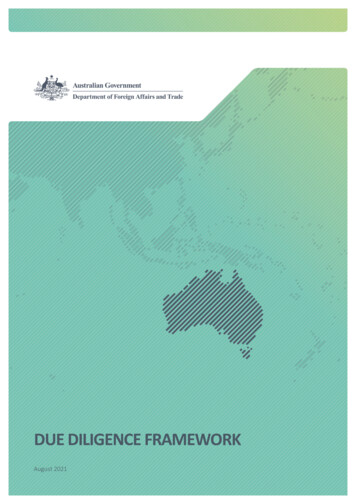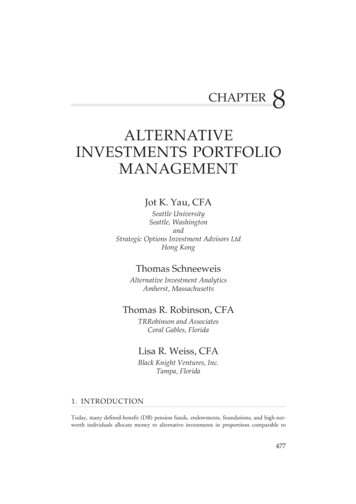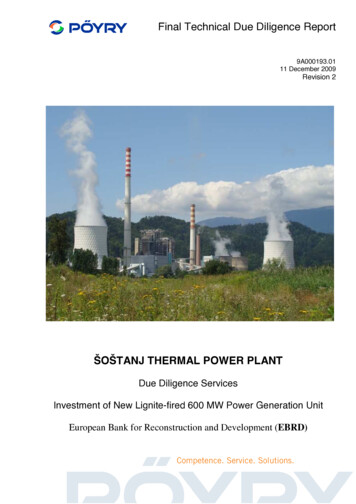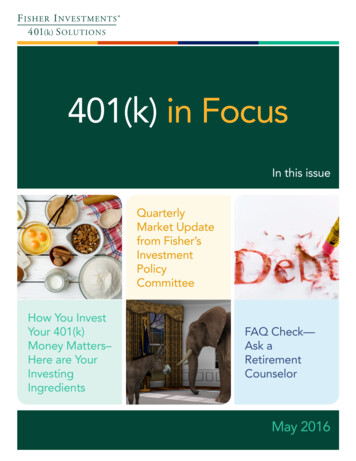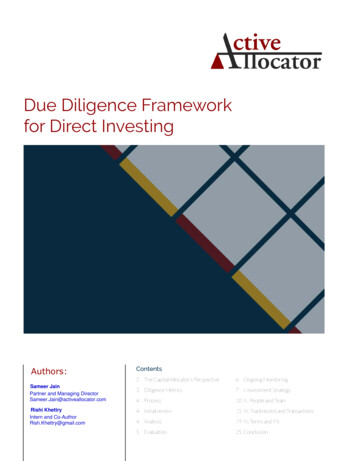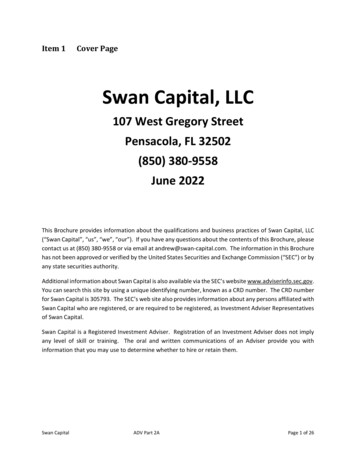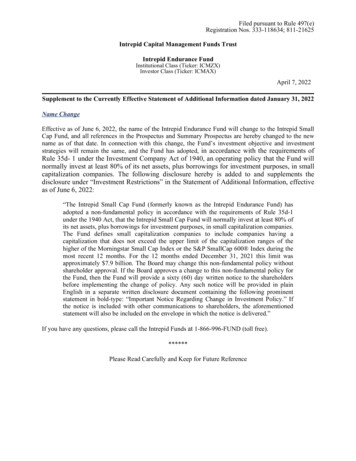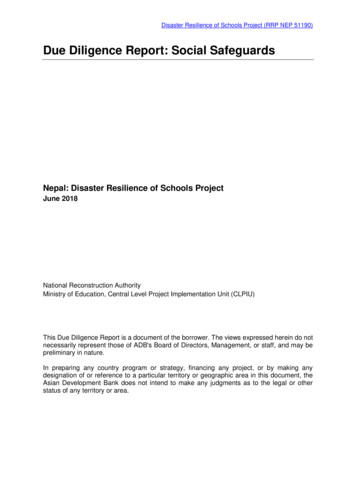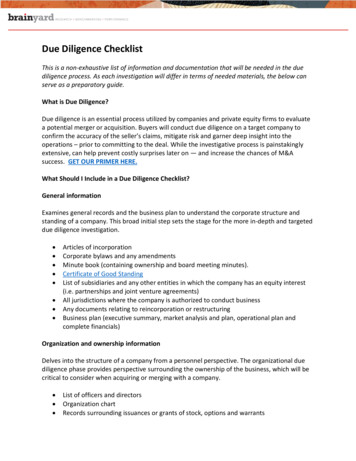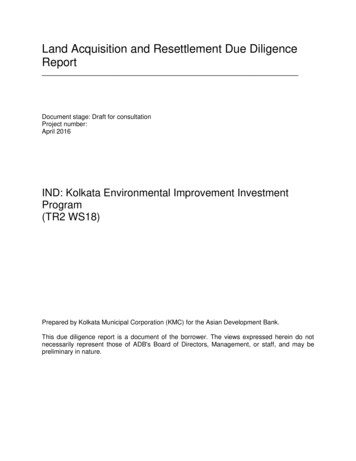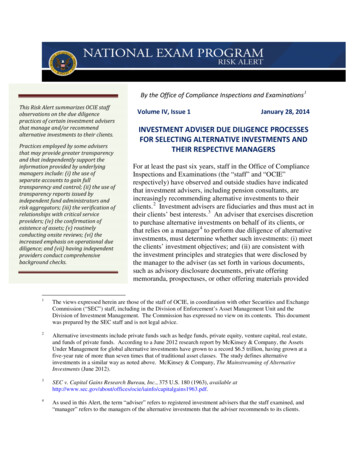
Transcription
By the Office of Compliance Inspections and Examinations 1This Risk Alert summarizes OCIE staffobservations on the due diligencepractices of certain investment advisersthat manage and/or recommendalternative investments to their clients.Practices employed by some advisersthat may provide greater transparencyand that independently support theinformation provided by underlyingmanagers include: (i) the use ofseparate accounts to gain fulltransparency and control; (ii) the use oftransparency reports issued byindependent fund administrators andrisk aggregators; (iii) the verification ofrelationships with critical serviceproviders; (iv) the confirmation ofexistence of assets; (v) routinelyconducting onsite reviews; (vi) theincreased emphasis on operational duediligence; and (vii) having independentproviders conduct comprehensivebackground checks.Volume IV, Issue 1January 28, 2014INVESTMENT ADVISER DUE DILIGENCE PROCESSESFOR SELECTING ALTERNATIVE INVESTMENTS ANDTHEIR RESPECTIVE MANAGERSFor at least the past six years, staff in the Office of ComplianceInspections and Examinations (the “staff” and “OCIE”respectively) have observed and outside studies have indicatedthat investment advisers, including pension consultants, areincreasingly recommending alternative investments to theirclients. 2 Investment advisers are fiduciaries and thus must act intheir clients’ best interests. 3 An adviser that exercises discretionto purchase alternative investments on behalf of its clients, orthat relies on a manager 4 to perform due diligence of alternativeinvestments, must determine whether such investments: (i) meetthe clients’ investment objectives; and (ii) are consistent withthe investment principles and strategies that were disclosed bythe manager to the adviser (as set forth in various documents,such as advisory disclosure documents, private offeringmemoranda, prospectuses, or other offering materials provided1The views expressed herein are those of the staff of OCIE, in coordination with other Securities and ExchangeCommission (“SEC”) staff, including in the Division of Enforcement’s Asset Management Unit and theDivision of Investment Management. The Commission has expressed no view on its contents. This documentwas prepared by the SEC staff and is not legal advice.2Alternative investments include private funds such as hedge funds, private equity, venture capital, real estate,and funds of private funds. According to a June 2012 research report by McKinsey & Company, the AssetsUnder Management for global alternative investments have grown to a record 6.5 trillion, having grown at afive-year rate of more than seven times that of traditional asset classes. The study defines alternativeinvestments in a similar way as noted above. McKinsey & Company, The Mainstreaming of AlternativeInvestments (June 2012).3SEC v. Capital Gains Research Bureau, Inc., 375 U.S. 180 (1963), available italgains1963.pdf.4As used in this Alert, the term “adviser” refers to registered investment advisers that the staff examined, and“manager” refers to the managers of the alternative investments that the adviser recommends to its clients.
by the manager). 5 The due diligence process can be more challenging for alternative investmentsdue to the characteristics of private offerings, including the complexity of certain alternativeinvestment strategies.The staff examined 6 the due diligence and related investment advisory processes of certainadvisers to pension plans and funds of private funds in order to evaluate how these advisers: (i)performed their due diligence; (ii) identified, disclosed, and mitigated conflicts of interest (e.g.,benefits to the adviser or its employees for allocations made to private funds); and (iii) utilizedexperienced investment teams when evaluating complex investment strategies and fundstructures. 7I. Staff Observations – Industry PracticesA. Industry TrendsThe staff observed several widespread trends regarding advisers’ due diligence processes. 8Several of these observations are noted below.i. Advisers Are Seeking More and Broader Information and Data Directly fromManagers of Alternative Investments Position-Level Transparency. The staff noticed increased requests from advisers, ascompared to the staff’s experience in prior time periods, for position-level transparency ofthe alternative investments. This observation was confirmed through discussions with theadvisers. The staff further noted that while some managers were willing to provideadditional transparency, others were reluctant to share detailed information about theiralternative investments. In particular, these managers were sensitive to sharing position-level5The staff observed that, in general, registered advisers performed distinct due diligence reviews of both thealternative investment fund under consideration and its manager.6The staff conducted more than ten examinations of SEC-registered investment advisers, pursuant to Section 204of the Investment Advisers Act of 1940 (“Advisers Act”). The staff’s examinations focused on advisers thatinvested in or recommended private fund and fund of private fund investments (e.g., hedge funds and privateequity funds). As of the time of the examinations, these advisers managed approximately 2 trillion in investorassets. The staff did not examine commodity pools and registered investment companies that pursue alternativestrategies.7Staff from the Division of Enforcement brought a settled enforcement action, which alleged that certain fundadvisers did not perform two of the five elements of the due diligence evaluation that they had represented totheir clients they would undertake. In addition, the staff alleged that the advisers failed to adequately respond toinformation that they received, which suggested that the identity of the fund’s outside auditor was in doubt andthat there existed a potential conflict of interest between one of the fund’s principals and its purported outsideauditor. In the Matter of Hennessee Group LLC and Charles J. Grandante, Investment Advisers Act ReleaseNo. 2871 (April 22, 2009), available at df.8The staff does not take a position regarding the compliance effectiveness or ineffectiveness of the industrypractices discussed in this section of this Risk Alert. The adequacy of the industry practices discussed in thisRisk Alert can be determined only with reference to the profile of each specific firm and other facts andcircumstances.2
information, which they felt may compromise their ability to execute their strategies.Position-level transparency was typically used by the advisers’ risk assessment teams to: (i)fine-tune analyses of market sector exposures; (ii) identify position concentrations across theclient’s entire portfolio; and (iii) identify individual positions that may present risks that wereanomalous or inconsistent with managers’ stated investment strategies. The position-leveltransparency ultimately provided to the advisers by the alternative investment managerstended to be the result of a process of negotiation between advisers and managers anddepended on several factors, including the relative influence of the investors and whether themanager viewed position-level transparency as sensitive proprietary information. Separate Account Management. Some advisers recommended that their clients’ assets bemanaged within a separate account to: (i) provide full transparency and greater control overhow the assets are invested (the manager’s authority over the assets is limited to tradingauthority); (ii) allow for better monitoring of the investment portfolio’s liquidity andvaluation; and (iii) reduce the ability of a manager to misappropriate client assets or chargeunauthorized fees or expenses. The staff understands that many managers continue to prefera pooled investment structure, based on their beliefs that such structures minimize expenses,increase operational efficiency, and reduce the risk of inequitable treatment of investors. Aswith the degree of position-level transparency, the staff noted that the resulting investmentstructure was increasingly determined through a negotiation between managers and advisers.The staff also observed that the key factors in such negotiations were the susceptibility ofassets to misappropriation, transparency into the alternative investment funds’ portfolioholdings, expenses incurred, and efficiency of operations.ii. Advisers Are Utilizing Third Parties to Supplement Analyses and ValidateInformation Regarding Alternative Investments Portfolio Information Aggregators (Risk Aggregators). The staff noticed, as compared toprevious staff observations and as confirmed by the advisers examined, that advisersincreased their use of portfolio information aggregators. Aggregators are generally thirdparty service providers that receive detailed portfolio-level information from privatealternative investment funds, aggregate that information and transmit the aggregatedinformation to advisers conducting due diligence. Advisers used the aggregated informationto make broad assessments of the risks of the particular alternative investments. Theaggregated information provided to advisers by aggregators was intended to control thedisclosure of sensitive information regarding the alternative investment fund’s specificpositions. The staff observed that in some cases the use of aggregators was a compromisebetween the adviser and the manager to resolve differing preferences for position-leveltransparency between investors and managers.Third-Party Service Provider Verification of Relationships and Assets. The staff observedthat many advisers were independently verifying alternative investment relationships andassets with key third-party service providers, such as administrators, custodians, and auditors.As gatekeepers, these key service providers play a very important role for private alternativeinvestment funds. As such, the staff observed that due diligence professionals appeared tohave placed a greater emphasis on verifying the existence of these relationships, and, in some3
cases, also were verifying that the assets were in fact serviced by the administrator and heldat the custodians identified. In addition, the staff observed that if the adviser was not familiarwith a service provider, some advisers would conduct a certain amount of due diligence onthe service provider in an effort to ensure that the service provider can provide an adequatelevel of service to the alternative investment. Independent Administration. The staff observed that some advisers would not make a newinvestment or recommendation in a private alternative investment fund if the private fund didnot have an independent third-party administrator. While not required to do so by law, thestaff observed that many advisers invested exclusively with managers that engaged anindependent administrator to conduct comprehensive fund administration services such asperforming net asset value calculations, fund accounting, trade reconciliation, and processingand recording shareholder activity. The staff understands that the genesis for such anadviser-mandated requirement is the belief that independent administrative services maymitigate certain investment and operational risks, such as the misappropriation of investorassets, and ensures segregation of duties. Third-Party Administrator-Issued Transparency Reports. The staff observed that manyadvisers have started receiving “transparency reports” directly from, and independentlyproduced by, third-party administrators for the benefit of alternative investment investors.These reports are designed to provide investors with periodic reporting and an increased levelof transparency with respect to the alternative investments’ positions. An administrator’sreport typically includes information about an alternative investment’s: (i) net asset value andthe percentage of its investments that are confirmed by the administrator with independentcustodians; (ii) custodians holding its investments; (iii) percentage of investments that arepriced by a third-party administrator; and (iv) assets and liabilities which are measured at“fair value” and are categorized using the fair value hierarchy (Level 1, 2, or 3) establishedunder FASB ASC 820, Fair Value Measurements. Independent Background Checks. The staff observed that most advisers employed theservices of third-party firms to conduct comprehensive background checks on the managersand their key personnel. The staff also observed that many advisers implemented the use ofbackground checks to supplement their own due diligence processes. The background checkservices were typically outsourced to third-party firms specializing in such services and oftenincluded investigating employment history, legal and regulatory matters, news sources, andindependent reference checks. Regulatory History Review. The staff observed that some advisers utilized FINRABrokerCheck, a publicly available tool, 9 to research the backgrounds of current and formerFINRA registered brokerage firms and individual broker-dealer registered representatives.Along with BrokerCheck, the staff also observed that some advisers reviewed regulatoryfilings, such as Form ADV — available on the Commission’s Investment Adviser PublicDisclosure website 10 — and requested that the manager provide the adviser with any9Available at okerCheck/.10Available at in/iapd SiteMap.aspx4
examination-related letters from the SEC. The staff understands that advisers typically usedthis information to identify important regulatory issues and potential control weaknesses atthe managers.iii. Advisers Are Performing Additional Quantitative Analyses and Risk Measureson the Alternative Investments and Their Managers Detection of Manipulation of Performance Returns. As compared to the staff’s observationsin earlier time periods, the staff observed that advisers were increasing the use of quantitativeanalysis in an attempt to detect aberrations in investment returns. This measure is intended toidentify managers that have falsified or otherwise manipulated their returns. Advisersconfirmed their increased use of these measures, which typically included: (i) bias ratio; (ii)serial correlation; and (iii) “skewness” of the return distribution. These measures also wereanalyzed in conjunction with factor analysis of the returns in order to detect suspect returnsthat may be an indication of manipulation. Supplementation of Investment-Level Decision-Making. The staff observed that advisershave increased their use of quantitative risk measures to supplement investment-leveldecision-making processes. The risk measurements supplemented the investment duediligence process (e.g., through measures such as factor analysis to provide an indication asto how closely a manager was implementing the stated strategic approach). The staff alsoobserved that some advisers’ risk teams used sophisticated quantitative measures to identifypotential problems before those problems would manifest in performance returns or adversereports from the manager.iv. Advisers Are Enhancing and Expanding Their Due Diligence Processes andFocus Areas Operational Due Diligence Focus. The staff observed that although many advisers havealways had a focus on operational due diligence, some advisers have increased their efforts inthis critical area and other advisers established operational due diligence groups. 11 Forexample, the staff found that many advisers had experienced, dedicated operational teamswith the ability to veto any alternative investment manager candidate that did not satisfy ateam’s review. Among other things, this review may include evaluation of the manager’spolicies and procedures regarding valuation. Legal Documents Review. The staff observed that most advisers included a review of legaldocuments as part of their due diligence process. In addition, the staff observed that someadvisers focused greater attention on legal reviews in an effort to detect legal document risk.Document risk may include unique contractual provisions or preclusions that present uniquerisks to investors, such as the inability of an investor to liquidate its investment upon certainevents in the alternative investment fund. Legal analysis, which was generally conducted by11Operational Due Diligence generally focuses on non-investment risk such as business operations risk and itsassociated control environment, including controls related to managing conflicts.5
the adviser’s legal staff, may include the review of offering materials, side letters,subscription agreements, and counterparty agreements. Investment Fund Redemption Terms and Liquidity of the Portfolio. The staff observed thatadvisers’ due diligence teams tended to focus closely on liquidity issues. The staff wasinformed that this increased attention was likely attributed to managers imposing redemptionrestrictions on investors during the financial crisis. Specifically, advisers generally assessedthe appropriateness of redemption terms in light of the underlying portfolio composition toidentify significant mismatches in liquidity. In particular, advisers to alternative investmentsthat invest in other alternative investments appeared to be more sensitive to the liquidityterms of the underlying managers’ portfolios to ensure that they corresponded with theliquidity terms of their own alternative investments. Onsite Visit Requirement. The staff observed that most advisers included onsite visits tomanagers as part of their investment, risk management, and operational due diligencereviews. Advisers also informed the staff that onsite visits helped due diligence teams: (i)understand the culture of the manager; (ii) detect instances where dominant individuals andinadequate control environments may exist; (iii) and provide increased access to reviewdocuments and to speak with the manager’s personnel. Audited Financial Statements Review. The staff observed that, although many advisers havepreviously received and reviewed the audited financial statements of private alternativeinvestments, some advisers have recently expanded their review of such records. Forexample, some advisers were reviewing the audited financial statements, among othersources, to identify possible related party transactions and to identify valuation concerns.B. Warning Indicators or Awareness Signals for Concern For AdvisersAdvisers utilizing some or all of the due diligence methods noted above did so in an attempt toidentify certain risk indicators during their investment, operational, and risk managementreviews. Some of these indicators, which are noted below, led advisers to conduct additional duediligence analysis, to request that the manager make appropriate changes, or to reject (or veto)the manager or the alternative investment. 12i. Investment 12Managers that were unwilling to provide requisite transparency regarding portfolio holdingsto the adviser;Performance returns that did not correlate with known factors associated with the manager’sstrategy, as described by the manager;Lack of clear research and investment processes; andLack of an adequate control environment and segregation of duties between investmentactivities and business unit controllers (e.g., managers dominating the valuation process).Staff has observed that, while firms typically have dedicated groups in the areas specified in this section, thesegroups usually work in close conjunction and have some degree of overlap.6
ii. Risk Management Alternative investment portfolio holdings that showed a high concentration in a singleinvestment position, or a heavy concentration in a single sector, for a purportedly diversifiedinvestment strategy;Manager personnel that appeared to be insufficiently knowledgeable about a sophisticatedstrategy they were purportedly implementing;Manager investment style that appeared to have drifted over time; andInvestments, as described by the manager, that appeared to be overly complex or opaque.iii. Operational Lack of a third-party administrator or an unknown/unqualified administrator;Use of an auditor that may not have significant experience auditing private investment fundsor is an unknown auditor;Multiple changes in key service providers, such as auditors, prime brokers, or administrators;Concerns identified in audited financial statements such as qualified opinions, related partytransactions, or valuation concerns;Background checks that revealed unfavorable regulatory history, bankruptcy filings, orserious legal issues of the manager or key personnel;Identification of undisclosed potential conflicts of interests, such as compensationarrangements or business activities with affiliates;Insufficient operational infrastructure, including an inadequate compliance program; andLack of a robust fair valuation process.II. Staff Observations – Compliance With the Advisers ActDuring its examinations, in addition to collecting the information about current practicesdescribed above, the staff also assessed advisers’ compliance with applicable laws, rules andregulations.A. Compliance ProgramsAdvisers are required by Rule 206(4)-7 under the Advisers Act to adopt and implement writtenpolicies and procedures reasonably designed to prevent violations of the Advisers Act and toannually review the adequacy of those policies and procedures and the effectiveness of theirimplementation. These requirements include: (i) naming a Chief Compliance Officer (“CCO”)to administer their programs; (ii) adopting compliance policies and procedures; and (iii)completing annual reviews of the effectiveness of their compliance policies and procedures.Additionally, while typically not incorporated into the advisers’ compliance manuals, many ofthe advisers examined by the staff had written, formal due diligence policies and procedures orguidance in place; those that did not had, at a minimum, some type of informal due diligenceframework in place. Below are some areas where material deficiencies or control weaknesseswere observed in some of the examinations.7
Annual Review. The staff observed that some advisers, for whom investing in orrecommending alternative investments was a key portion of their business, did notinclude in their annual review a review of their due diligence policies and procedures forsuch investments. Disclosures Made to Clients. The staff observed that advisers’ disclosures sometimesdeviated from actual practices, and that advisers with material deficiencies in theirdisclosures failed to review disclosures for consistency with fiduciary principles or todescribe notable exceptions made to the adviser’s typical due diligence process. Marketing Claims. The staff observed that some advisers’ marketing materials containedinformation about the scope and depth of the due diligence process that could bemisleading or statements that appeared to be unsubstantiated. For example, one adviseroverstated the number of research analysts and their average years of experience in theindustry.In addition to material deficiencies, the staff also made the following observations: Policies and Procedures. The staff observed that advisers were more likely to have duediligence processes that were consistently applied if they adopted written policies andprocedures that were detailed and required adequate documentation. These advisersincorporated compliance oversight into their business and operations and were able to usethese policies as an internal guide in the selection and monitoring of portfolioinvestments and their related third-party managers. Oversight of Service Providers. The staff observed that in some instances, advisersdelegated certain responsibilities to third-party service providers. Advisers that did notconduct periodic reviews of their service providers to determine whether the serviceproviders were abiding by the terms of their agreements were more likely to havedeficiencies in meeting those responsibilities.B. Code of EthicsAll advisers registered with the SEC must adopt and enforce a written code of ethics reflectingthe adviser’s fiduciary duties to its clients.13 At a minimum, such codes should set forth theminimum standard of conduct for all “supervised persons” (i.e., employees, officers, directors,and other persons that the adviser is required to supervise) and must address personal securitiestrading by these persons. The code of ethics that each adviser chooses to adopt and implementshould reflect its fiduciary obligations to its clients and the fiduciary obligations of the personsunder its supervision, and require compliance with the federal securities laws. 13Limited offering review. The staff observed instances in which advisers invested in orrecommended a limited offering to their clients, while they also permitted access persons toacquire an interest in that same limited offering but with preferential investment terms (i.e.,Advisers Act Rule 204A-1.8
greater liquidity or reduced fees). Such arrangements create a conflict of interest that mayinfluence the adviser’s due diligence process to the detriment of clients — the advisoryemployee receiving the preferential terms may be incentivized by their own financialinterests rather than the best interest of advisory clients. Furthermore, the staff identifiedinstances where advisers did not maintain a record of any decision, and the reason supportingthe decision, to approve the acquisition of securities by access persons, as required by Rule204-2(a)(13)(iii).III. ConclusionThe staff hopes that this overview of examinations concerning the due diligence practices ofadvisers will help to support the compliance programs of registrants.If you suspect or observe activity that may violate the federal securities laws or otherwise resultin harm to investors, please notify us at: http://www.sec.gov/complaint/info tipscomplaint.shtml.This Risk Alert is intended to highlight for firms risks and issues that the staff has identified in the courseof examinations regarding investment adviser due diligence processes for selecting alternativeinvestments and alternative investment managers. In addition, this Risk Alert describes factors that firmsmay consider to (i) assess their supervisory, compliance, and/or other risk management systems relatedto these risks, and (ii) make any changes, as may be appropriate, to address or strengthen such systems.These factors are not exhaustive, nor will they constitute a safe harbor. Other factors besides thosedescribed in this Risk Alert may be appropriate to consider, and some of the factors may not be applicableto a particular firm’s business. While some of the factors discussed in this Risk Alert reflect existingregulatory requirements, they are not intended to alter such requirements. Moreover, future changes inlaws or regulations may supersede some of the factors or issues raised here. The adequacy of supervisory,compliance, and other risk management systems can be determined only with reference to the profile ofeach specific firm and other facts and circumstances.9
2 Alternative investments include private funds such as hedge funds, private equity, venture capital, real estate, and funds of private funds. According to a June 2012 research report by McKinsey & Company, the Assets Under Management for global alternative investments have grown to a record 6.5 trillion, having grown at a
